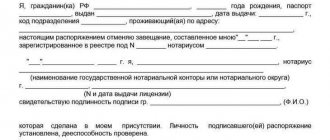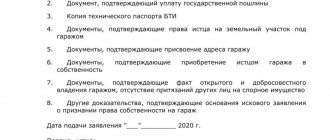Often, citizens who own land plots believe that since the plot is in their ownership, it means they can build any real estate on it. However, this is not at all true. In this article we will examine in detail the question of what such a judgment can lead to and how its negative consequences can be prevented. So, you own a plot of land on which you want to build, for example, a residential building. According to the law, every citizen must notify the local government about such intentions before starting construction, and upon completion, notify the same administration about the completion of construction, attaching a technical plan for the constructed facility. This is a moment you can't miss. It is necessary to build real estate and notify government authorities so that the construction is not recognized as unauthorized construction.
According to the Civil Code of the Russian Federation, art. 222, not only real estate that was built in the absence of building permits, but also a building erected in violation of town planning and building codes will be considered an unauthorized construction. If the property is recognized as a self-construction, it will not be registered in the cadastral register and the ownership of it will not be registered.
What objects are considered unauthorized construction?
An unauthorized construction in 2021 is considered to be one that:
- Built on a plot of land that was not provided in accordance with the established procedure. The land must be owned or disposed of by persons on the basis of other title documents (lease agreement, purchase and sale agreement, agreement of perpetual use, right of lifelong inheritable possession).
- Built on land on which the construction of a specific type of object is prohibited, i.e. does not allow the type of permitted use.
- Built without obtaining approvals and (or) construction permits from local authorities.
- Has violations of town planning standards, construction rules, fire safety, etc.
Correction for six hundred
The so-called dacha amnesty has existed in Russia for 14 years. It was first introduced on September 1, 2006. Now legislators want to extend this order for another 5 years.
Perhaps because dachas have acquired a new status during the coronavirus pandemic - places not only for summer holidays, but also for permanent living. After all, the same self-isolation is easier to endure in nature.
Rossiyskaya Gazeta talked about all the nuances of the simplified procedure for registering dacha real estate as property with Nikita Chaplin, First Deputy Chairman of the Moscow Regional Duma, Chairman of the Union of Summer Residents of the Moscow Region.
Nikita Yuryevich, how many new owners appeared during the dacha amnesty?
Nikita Chaplin : Since the beginning of the amnesty, rights have been issued for more than 13 million real estate properties. At the same time, in Russia there are about 72 thousand horticultural and gardening associations, in which there are more than 60 million property owners.
I would like to note that this spring the number of residents in gardening associations has actually doubled compared to previous seasons. Employees of enterprises, students, schoolchildren who were sent to work remotely, and pensioners came to their dachas. Many also had to spend their holidays not at resorts, but at their summer cottages. Therefore, many began to delve into the issues of real estate registration. It was necessary to legalize the property both for those who decided to connect communications to the house - water supply, gas, and for those who decided to rent out the dacha. However, the restrictions introduced in 2020 have significantly reduced the opportunity to take advantage of the dacha amnesty, which is due to end on March 1, 2021.
The dacha amnesty - a simplified procedure for registering ownership of buildings - began to operate in 2006. Summer residents were given the opportunity to register ownership of their land using one title document: it could be a deed, an agreement, a certificate, or an extract from the household register. To register buildings, at first it was enough to fill out a declaration for a house, garage or outbuilding and attach a document on ownership of the land plot, paying a state fee of 350 rubles. Gradually, the procedure for registering buildings became more complicated: from January 1, 2021, an additional document was required - a technical plan, which can only be drawn up by a cadastral engineer.
Structures registered after January 1, 2021 can be seen on the public cadastral map: they are indicated by red rectangles. That is, all buildings registered starting from 2021 are “linked” to coordinates on the ground. In 2021, an additional requirement appeared - the presence of data on the boundaries of the land plot on which the building was erected entered into the Unified State Register. Simply put, without land surveying it is impossible to register a single building on the site. And if in 2006 a summer resident could have 2 certificates of ownership: for land and for buildings without any coordinates, now when registering ownership in the Unified State Register of Real Estate, information about the coordinates of both the land plot and the building is entered.
From March 1 to August 4, 2021, the dacha amnesty did not work, but a notification procedure for registering buildings in the SNT was in effect: it was necessary to submit notifications about the start and completion of construction, that is, essentially go through the same procedure as in populated areas where it was required obtaining permission to build or reconstruct a residential building. To receive a notification from the administration about the compliance of the structure with urban planning parameters, it was necessary to additionally order a GPZU (urban planning plan for the land plot), obtain a conclusion on the absence of minerals, and in some cases, approval from the Federal Air Transport Agency (if construction was taking place in the airport area), as well as from the Department of Cultural Affairs heritage (if the dacha is included in the territory of cultural heritage).
Considering that, for example, in the Moscow region 40% of the territory is included in the airfield zone, every third applicant had to obtain approval. The procedure for obtaining approvals, despite the gradual digitalization of these processes, was quite complex and costly. This significantly complicated the registration of ownership of houses in SNT: during this period, 90% fewer buildings were registered than in similar previous periods. In fact, registration of real estate in SNT during the period of the notification procedure practically stopped.
When preparing the bill to extend the dacha amnesty until 2026, legislators took into account the numerous wishes of owners of land plots for individual housing construction and personal subsidiary plots to simplify the procedure for registering buildings. The development of infrastructure in rural areas, preferential mortgages for large families, and “wooden mortgages” gave impetus to low-rise construction. Since 2021, many families, when choosing between an apartment or a country house, have increasingly begun to choose their own home.
Since from January 1, 2021, urban planning requirements for residential buildings both in SNT and in populated areas are uniform, and registration at the place of residence has become possible in gardening associations, the legislator proposed expanding the provisions of the dacha amnesty to plots in populated areas. In this regard, it seems that a 5-year period for a simplified procedure for registering real estate is realistic for everyone who wants to legalize their rights.
Does the dacha amnesty apply to any other buildings besides houses? What do you need now to become the owner of a summer house and other real estate under a simplified procedure?
Nikita Chaplin : In a simplified manner, you can register capital buildings: a residential or garden house (no higher than 20 meters and 3 floors, at a distance no closer than 3 meters from the fence), outbuildings, garage. The criterion for a building to be capital is the impossibility of moving it to another location. For example, a brick house can only be demolished and rebuilt, but a construction shed can be loaded with a crane and installed on a new site. Whether to register prefabricated frame-panel houses is the right of every owner. There are also summer kitchens equipped with the latest technology: barbecue, water supply, electricity. They can also be classified as capital buildings. It is important to note that from August 4, 2021, when the new edition of the Town Planning Code came into force, any capital construction can be recognized as unauthorized if it is not registered.
To register a building or structure, you will need to call a cadastral engineer who will take measurements, determine the coordinates on the site and prepare a technical plan.
And at this stage, a large number of land owners have difficulties. If the boundaries of the land plot are not entered into the Unified State Register or are entered incorrectly, you first need to correctly establish the boundaries of the plot. From August 4, 2021, a mandatory condition for registering a building is the presence of information about the boundaries of the land plot included in the Unified State Register of Real Estate. If the site has not passed the land surveying procedure or there are errors in the boundaries, then Rosreestr will decide to suspend registration actions or refuse registration if the errors are not eliminated.
System registry errors are also common, when a whole array of land plots are entered into cadastral registration with an error. That is, the owners of the plots have no disputes over fences, the linear dimensions correspond to the title document (for example, plots of 6 acres measuring 20 x 30 m), and when the cadastral engineer “links” the house to the coordinates, it turns out that it formally falls on the border between two in plots, on someone else’s plot or less than 3 meters to the border entered in the Unified State Register of Real Estate.
If the neighbors are adequate, the issue is resolved by mutual agreement: the same cadastral engineer prepares land plot plans to correct registry errors, and Rosreestr makes changes to the Unified State Register of Real Estate. The situation is more complicated when neighbors believe that they should not have to pay again for boundary work to mark the boundaries of their property. Then you have to go to court and the case can drag on for 6-12 months.
If everything is in order with the boundaries of the plot, to register the building you need to submit to Rosreestr a document on the ownership of the land plot, a technical plan prepared by a cadastral engineer, a declaration of real estate (as a rule, filled out by the same cadastral engineer based on the data from his technical plan) , owner’s passport and pay a state fee of 350 rubles.
What about the land? How can I register a plot of land that was once given for use in a simplified manner?
Nikita Chaplin : In a simplified manner, on the basis of any title document, you can register a land plot provided before the date of entry into force of the Land Code (before October 30, 2001). If the land was provided for personal farming, gardening, vegetable gardening, individual housing construction, then the “amnesty” for it is unlimited.
Can only a garden plot be registered as a property? What about the garden one?
Nikita Chaplin : No. It is impossible to do it in the garden. It can only be issued on a long-term lease for 49 years. It is now possible to renew a lease agreement for a garden plot into ownership only if the type of its permitted use is changed to “gardening”, “for personal farming” or “for individual housing construction”. The decision to change the type of permitted use of the site is made in this case by the administration of the municipality. At the same time, the site will be put up for auction in the future - an auction for the right to conclude a lease. After the tenant builds and registers a residential or garden house, he will be able to purchase this plot of land without bidding for 3% of the cadastral value.
After registering ownership of the dacha, how much will the family's expenses increase? Are taxes high?
Nikita Chaplin : Many summer residents who have not registered the rights to their buildings motivated their reluctance to register their property with high taxes. But in most cases these are excuses. The increased tax - 2% - is provided only for owners of cottages worth over 300 million rubles; this is a luxury tax. The federal tax rate for other garden and residential buildings is 0.1% of the cadastral value, while regions have the right to increase this rate to no more than 0.3%. If we take an average residential building with an area of 150 square meters in the Moscow region, then its cadastral (inventory) value, close to the market value, will be 3.6 million rubles. At the same time, the tax base for residential and garden houses is reduced by 50 sq.m.
Thus, at a rate of 0.1%, the tax will be 2,400 rubles per year. For a working owner, this is quite possible, and pensioners, people with many children and a number of other privileged categories of citizens are completely exempt from paying tax on 1 apartment, 1 house, 1 garage and 1 outbuilding, and also have a tax deduction of 6 acres per 1 plot of land. In addition to federal ones, municipalities have the right to establish local benefits, for example, completely exempt large families from land tax.
Therefore, there is no need to be afraid of taxes, but it is worth considering how much possible legal expenses will cost if a neighbor or the administration has a claim about the demolition of an unauthorized building. Also, if the house is registered, it is much easier to conclude an agreement with insurance companies. And main communications - gas and water - can only be connected to registered real estate properties.
Can they refuse to register a plot of land and buildings as their property if the land use and development rules and the urban planning plan for the area have not been approved? And if they can, then what should summer residents do?
Nikita Chaplin : Yes, such a situation may arise, but this does not deprive the copyright holder of a previously acquired right to a land plot. If registration was refused due to the absence of a land development plan or urban development plan, it is recommended to go to court and challenge this refusal. Registration of a house under the dacha amnesty on a land plot that has already been registered as a property cannot be refused if the category and type of permitted use of this plot have been established.
Are there any precedents when people began to rebuild their garden houses into residential ones on their summer cottages, in order to later register in them? How complicated is the procedure? How much money on average does it take to transform a summer house into a home suitable for year-round use?
Nikita Chaplin : As they say, construction can only be stopped, but not completed. Many summer residents began to develop their plots with small garden houses with an area of 25-30 square meters, which were gradually completed and eventually turned into full-fledged residential buildings of 100 square meters. The cost of reconstruction significantly depends on the original condition, design and engineering equipment of the garden house; on average, it is 10 thousand rubles per square meter.
The minimum requirements for a residential building are the availability of heating and electricity and sufficient height of living quarters (from 2.1 m). Moreover, the heating can be a stove, and the toilet can be outside, the main thing is that the temperature in the house can be maintained above 18 degrees all year round.
From January 1, 2021, registration in residential buildings was allowed in SNT territories in the same manner as in populated areas. If previously a summer resident had to prove that this is his only home, now it is enough to own a residential building. We have not seen a particular surge in the registration of residents in dacha and garden plots, since the majority have their own apartments in the city. Registration at a dacha is more relevant for those who are building their first home. These are residents who came from other regions, or young families who decided to build their own home.
It is important to note that each owner has the right to choose how to register their home. For example, if a garden house fully meets the criteria for a residential building, and a large family is in line to improve their living conditions, you can register the house as a garden house; this is not a violation of the law, so as not to lose the right to receive municipal housing.
To convert a garden house into a residential one, you need to obtain a conclusion on recognition of the house as residential, which can be prepared by a legal entity or individual entrepreneur that is a member of an SRO in the field of engineering surveys. Next, you need to contact the municipal administration for a resolution, after which the documents are transferred to Rosreestr.
The summer season is almost over. Is the infrastructure coping with the increase in summer residents who have decided to survive the coronavirus in nature? Or are there already difficulties with garbage disposal and parking?
Nikita Chaplin : The summer season began unusually early this year - in April. Some SNTs faced a shortage of electrical capacity, and there were some problems with waste removal, since regional operators planned their work in SNTs only in early May. But over the summer, problems with garbage removal, firewood and food delivery to SNT were resolved. With a shortage of electrical power, some summer residents switched from electric stoves (this is the main source of load on the network) to gas from cylinders (a 50-liter cylinder, even with intensive use, lasts for at least a month).
Regional and local authorities have made every effort to uninterruptedly meet the needs of summer residents: during the pandemic, energy suppliers were prohibited from disconnecting consumers if there was a current debt for utilities for 2021; food trucks were allowed to drive through all settlements and SNT to deliver products. As for parking in SNT territories, this is not a problem that arose yesterday, and each team solved it differently: in some villages there are places for parking cars, in others there has been a ban on parking cars on public lands for several years now - you can only park cars in their areas.
If the coronavirus pandemic drags on, many will continue to live in their dachas in the winter. Will SNT be able to ensure timely clearing of snow from the streets so that people can move around, go out on business and for shopping?
Nikita Chaplin : To support the infrastructure of SNT, first of all, funds are needed that summer residents collect from membership and target fees. In 2021, during the spring-summer season, the main problem arose in SNT in holding general meetings to approve the budget, when restrictions on public and mass events were introduced in the regions, as well as a requirement for self-isolation for older residents. The federal authorities met the summer residents halfway and promptly amended the law and secured the right of summer residents to vote on all issues in 2021 in absentia. Therefore, I think that all SNT will be able to make the necessary decisions both on the budget and on the scope of work, including on snow removal in the winter. So good owners and friendly teams will cope with problems successfully.
How to register a self-construction
If the property has the “status” of self-building and is owned or owned by someone, then the state will first give time to eliminate the violations (for example, reduce the area of the building). Violations must be eliminated within a specified period, otherwise the authorized body will issue a demolition order. When a building is not registered, there are two main ways to register it in accordance with the requirements of the law - administratively or judicially.
The first way is to legalize self-construction administratively.
The legalization procedure through the administration is processed “retroactively.”
- To begin with, a notification about the start of construction should be submitted to the administration with a description of the construction parameters (height, number of floors, area, etc.).
- If no objections are received to the notification, it is necessary to conclude an agreement with the cadastral engineer for the implementation of the technical plan.
- Next, a formal notification of completion of construction is sent to the administration along with a technical plan.
If there are no violations, the local government authority will send you a notification about the compliance of the constructed facility with urban planning standards and transfer the documents to Rosreestr. But it should be said right away that you can receive a refusal from the executive body at any stage of the above. This method is suitable for those who have built real estate on the lands of individual housing construction or private plots. For SNT there is a “dacha amnesty”, which makes it possible to register a residential building without notification of construction. You can register your rights under a simplified procedure until March 1, 2021 .
The second way is to legalize unauthorized construction through the court
The basis for transferring the case to court is the refusal of local governments to formalize the unauthorized construction. The court will order a mandatory forensic examination, which will confirm the capital construction of the building, its compliance with the requirements of GOSTs and SNiPs, etc. But you can order an independent construction expert yourself before filing a lawsuit in order to find out in advance about the presence of violations and correct them. Sometimes the conclusion of a pre-trial examination is sufficient for the court and there will be no need for a judicial examination. When you already have in your hands a refusal from a government agency, a technical passport for a capital construction project (CFU), an extract from the Unified State Register of Land Registers for a land plot, then you should then competently draw up a statement of claim, in which you must take into account that:
- the land plot must be owned, inherited for life, permanent (indefinite) use;
- the building must comply with the category of land and type of permitted use (VR);
- confirmation that a specific building does not violate the rights of third parties (neighbors) (the norms for indentation during construction are observed, etc.).
- the reasons for going to court should be indicated, i.e. state the reason for unauthorized construction or the grounds for refusal of a construction permit.
Although both methods are not fast, but if the construction is important to you and in the future you plan to make various transactions with it, then you should be patient. If there are adequately substantiated reasons why the squatter building was erected, the court usually rules in favor of the plaintiff.
Why do you need to register garden real estate?
Dachas, country houses, garden houses and other capital construction structures must be registered as property in order to:
- they were not recognized as unauthorized construction and were not demolished legally;
- to avoid disagreements with neighbors regarding the location of residential and commercial buildings, as well as to eliminate disputes about the boundaries of land plots;
- receive compensation in case of damage caused by third parties or in case of demolition of buildings for municipal or state needs;
- eliminate the possibility of the Federal Tax Service charging property tax for 3 years and a fine, the amount of which is 20 percent of the amount of this tax;
- eliminate the possibility of problems when connecting gas, electricity and other utilities;
- gain the opportunity to make transactions with this property, as with any other property: donate, sell, inherit, insure, use as collateral for lending.
The dacha amnesty for registering unregistered buildings on garden plots is valid only until March 1 of the next year. The simplified procedure has become more complicated more than once, and no one can say for sure what will happen after the end of the program. One thing is certain: it will most likely not be simpler, faster and more accessible than it is now.
Fines for unauthorized construction 2021
The Code of Administrative Offenses of the Russian Federation established monetary penalties for the construction of real estate without permits
- For citizens from 2,000 to 5,000 rubles
- For officials from 20,000 to 50,000 rubles
- For legal entities from 500,000 to 1,000,000 rubles
When registering unauthorized construction, penalties cannot be avoided; they will have to be paid in any case, but the consequences may be more global. The further development of events is the liquidation of real estate. In order to avoid such consequences, as well as for the purposes of the legitimate use and operation of the property, we strongly recommend that you consider the issue of legalizing unauthorized construction.










